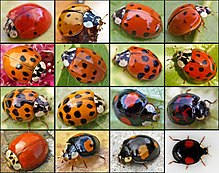Harmonia axyridis
| Harmonia axyridis | |
|---|---|
 |
|
| Scientific classification | |
| Kingdom: | Animalia |
| Phylum: | Arthropoda |
| Class: | Insecta |
| Order: | Coleoptera |
| Family: | Coccinellidae |
| Genus: | Harmonia |
| Species: | H. axyridis |
| Binomial name | |
|
Harmonia axyridis (Pallas, 1773) |
|
Harmonia axyridis, most commonly known as the harlequin, multicolored Asian, or simply Asian ladybeetle, is a large coccinellid beetle. This is one of the most variable species in the world, with an exceptionally wide range of color forms. It is native to eastern Asia, but has been artificially introduced to North America and Europe to control aphids and scale insects. It is now common, well known, and spreading in those regions, and has also established in South Africa and widely across South America.
This species is conspicuous in North America where it may locally be known as the Halloween ladybeetle. It earns this name as it often invades homes during October, in order to prepare for overwintering. In Japan, it is not generally distinguished from the seven-spot ladybird which is also common there.
When the species first arrived in the UK, it was labelled in jest as the "many-named ladybird" due to the great quantity of vernacular names. Among those already listed other names include multivariate, southern, Japanese, and pumpkin ladybird.
Harmonia axyridis is a typical coccinellid beetle in shape and structure, being domed and having a "smooth" transition between its elytra (wing coverings), pronotum, and head. It ranges from 5.5-8.5mm in size. The common color form, f. succinea, is orange or red in colouration with 0-22 black spots of variable size. The other usual forms, f. conspicua and f. spectabilis, are uniformly black with 2 or 4 red markings respectively. The pronotum is white with variable black patterning, ranging from a few black spots in an M formation to almost entirely black. The underside is dark with a wide reddish-brown border.
However, numerous other forms have also been recorded. Extreme forms may be entirely black all over, or feature unusual patterns of black, orange and red.
The large size of this species is usually the first clue to its identification. Despite variation, this species does not generally overlap in pronotal or elytral pattern with any other species, except in unmarked orange or red forms. In Europe it is similar to the much smaller Adalia decempunctata, while in America it is similar to the much narrower Mulsantina picta and spotless forms of Adalia bipunctata. When identification is difficult the underside pattern usually enables a reliable conclusion. Identification is most simple for the common forms, while less common varieties may take longer to identify. They always have reddish-brown legs and are obviously brown on the underside of the abdomen, even in the melanic colour forms.
...
Wikipedia
